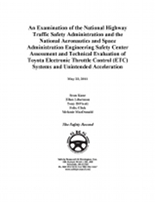When you’ve shelled out big bucks for a message, the dissenters have to be squashed – and fast. Yesterday, Toyota public relations rapid response team tried to bring the Toyota Unintended Acceleration (UA) problem back into its multi-million-dollar corral at the There’s Nothing to See Here, Folks Ranch.
Mike Michels, Vice President for External Communications of Toyota Motor Sales, U.S.A., wrote an editorial, in response to a well-reported and written story by the Huffington Post’s Sharon Silke Carty about one of the most significant physical findings of the NASA Engineering Safety Center’s (NESC) study of the electronic causes of unintended acceleration in Toyota vehicles: tin whiskers. Tin whiskers are crystalline structures that emanate from tin and other alloys used as solder on printed circuit boards. These nearly microscopic metal hairs can bridge circuits, leading to electrical shorts and significant malfunctions. They have caused failures at nuclear power plants and medical devices and downed satellites. While we don’t believe that they are the cause of UA in all Toyota vehicles. Clearly, tin whiskers have been strongly implicated as a cause of UA in some Toyota vehicles. Continue reading
